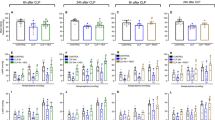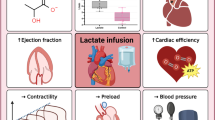Abstract
Vanelli, G., Hussain, S.N.A., Dimori, M. and Aguggini, G., 1996. Cardiovascular responses to glibenclamide during endotoxaemia in the pig. Veterinary Research Communications, 21(3), 187-200
The effects of blockading the ATP-sensitive potassium channel (K+ATP channels) on endotoxin-induced vascular derangements was studied. Escherichia coli endotoxin was infused (20 µg/kg per h) intravenously for 180 min into anaesthetized, mechanically ventilated, indomethacin-treated pigs. After 150 min of endotoxaemia, glibenclamide (a K+ATP channel blocker) was infused intravenously at 2 mg/kg per min for 5 min. The cardiovascular parameters were recorded before (control), every 30 min up to 150 min during endotoxaemia, and then at 5, 15 and 30 min after administration of glibenclamide. Infusion of endotoxin reduced the systemic arterial pressure to 60.6% ± 3.7% (p < 0.01) and increased the pulmonary arterial pressure by 75.9% ± 11.0% (p < 0.01) of the control values. Within 5 min, infusion of glibenclamide transiently but significantly reversed the systemic hypotension by raising the systemic vascular resistance, whereas the increased pulmonary arterial pressure was further augmented. Glibenclamide infusion did not influence the cardiac output. Within 30 min, the cardiovascular parameters had returned to the values induced by endotoxin, except for the systemic vascular resistance. Infusion of glibenclamide into normal pigs did not change the systemic pressure or resistance, but the pulmonary pressure and resistance were augmented transiently. These data suggest that, in pigs, the ATP-sensitive K+ channels may be one factor playing a role in the vascular changes due to endotoxaemia, especially in the systemic circulation.
Similar content being viewed by others
REFERENCES
Aguilar-Bryan, L., Nelson, D.A., Quanga, V., Humphrey, M.B. and Boyd, A.E., 1990. Photoaffinity labeling and partial purification of the beta cell sulfonylurea receptor using a novel biologically active glyburide analog. Journal of Biological Chemistry, 265, 8218–8224
Beasley, D., Cohen, R.A. and Levinsky, N.G., 1990. Endotoxin inhibits contraction of vascular smooth muscle in vitro. American Journal of Physiology, 258, H1187–H1192
Beech, D.J., Zhang, H., Nakao, K. and Bolton, T.B., 1993. K channel activation by nucleotide diphosphates and its inhibition by glibenclamide in vascular smooth muscle cells. British Journal of Pharmacology, 110, 573–582
Clapp, L.H. and Gurney, A.M., 1992. ATP-sensitive K+ channels regulate resting potential of pulmonary arterial smooth muscle cells. American Journal of Physiology, 262, H916–H920
Daut, J., Maier-Rudolph, W., Von Beckerath, N., Mehrke, G., Günther, K., and Goedel-Meinen, L., 1990. Hypoxic dilation of coronary arteries is mediated by ATP-sensitive potassium channels. Science, 247, 1341–1344
Davies, N.W., 1990. Modulation of ATP-sensitive K+ channels in skeletal muscle by intracellular protons. Nature, 343, 375–377
Esbenshade, A.M., Newman, J.H., Lams, P.M., Jolles, H. and Brigham, K.L., 1992. Respiratory failure after endotoxin infusion in sheep: lung mechanics and lung fluid balance. Journal of Applied Physiology, 53, 967–976
Imamura, Y., Tomoike, H., Narishige, T., Tagahashi, T., Kasuya, H. and Takeshita, A., 1992. Glibenclamide decreases basal coronary blood flow in anesthetized dogs. American Journal of Physiology, 263, H399–H404
Jackson W., 1993. Arteriolar tone is determined by activity of ATP-sensitive potassium channels. American Journal of Physiology. 265, H1797–H1803
Janigro, D., West, G.A., Gordon, E.L. and Winn, H.R., 1993. ATP-sensitive K+ channels in rat aorta and brain microvascular endothelial cells. American Journal of Physiology, 265, C812–C821
Julou-Schaeffer, G., Gray, G.A., Fleming, I., Schott, C., Parratt, J.R. and Stoclet, J.C., 1990. Loss of vascular responsiveness induced by endotoxin involved L-arginine pathway. American Journal of Physiology, 259, H1038–H1043
Kauser, K., Stekiel, W.J., Rubanyi, G. and Harder, D.R., 1989. Mechanism of action of EDRF on pressurized arteries: effect on K+ conductance. Circulation Research, 65, 199–204
Keung, E.C. and Li, Q., 1991. Lactate activates ATP-sensitive potassium channels in guinea pig ventricular myocytes. Journal of Clinical Investigations, 88, 1772–1777
Klemm, P., Ostrowski, J., Morath, T., Gruber, C., Martorana, P.A. and Henning, R., 1993. N-acetylserotonin prevents the hypotension induced by bacterial lipopolysaccharides in the rat. European Journal of Pharmacology, 250, R9–R10
Landry, D.W. and Oliveri, J.A., 1992. The ATP-sensitive K+ channels mediate hypotension in endotoxaemia and hypoxic lactic acidosis in dogs. Journal of Clinical Investigation, 89, 2071–2074
Liu, S., Adcock, I.M., Old, R.W., Barnes, P.J. and Evans, T.W., 1993. Lipopolysaccharide treatment in vivo induces widespread tissue expression of inducible nitric oxide synthase mRNA+. Biochemical and Biophysical Research Communications, 196, 1208–1213
Lückhoff, A. and Busse, R., 1990. Activators of potassium channels enhances calcium influx into endothelial cells as a consequence of potassium currents. Naunyn-Schmiedeberg's Archives of Pharmacology, 342, 94–99
MacNaul, K. and Hutchinson, N.I., 1993. Differential expression of iNOS and cNOS in human vascular smooth muscle cells and endothelial cells under normal and inflammatory conditions. Biochemical and Biophysical Research Communications, 196, 1330–1334
Minkes, R.K., Kvamme, P., Higuera, T.R., Nossaman, B.D. and Kadowitz, P.J., 1991. Analysis of pulmonary and systemic vascular responses to cromakalim, an activator of K+ ATP channels. American Journal of Physiology, 260, H957–H966
Miyoshi, H., Nakaya, Y. and Moritoki, H., 1994. Nonendothelial-derived nitric oxide activates the ATP-sensitive K+ channel of vascular smooth muscle cells. FEBS Letters, 345, 47–49
Mülch, A., Bassenge, E. and Busse, R., 1989. Nitric oxide synthesis in endothelial cytosol: evidence for a calcium-dependent and a calcium-independent mechanism. Naunyn-Schmiedeberg's Archives of Pharmacology, 340, 767–770
Nichols, C.G. and Lederer, W.J., 1991. Adenosine triphosphate-sensitive potassium channels in the cardiovascular system. American Journal of Physiology, 261, H1675–H1686
Post, J.M. and Jones, A.W., 1991. Stimulation of arterial 42K efflux by ATP depletion and cromakalim is antagonized by glyburide. American Journal of Physiology, 260, H848–H854.
Salvemini, D., Korbut, R., Änggárd, E. and Vane, J., 1990. Immediate release of a nitric oxide-like factor from bovine aortic endothelial cells by Escherichia coli lipopolysaccharide. Proceedings of the National Academy of Sciences of the USA, 87, 2593–2597
Samaha, F.F., Heineman, F.W., Ince, C., Fleming, J. and Balaban, R.S., 1992. ATP-sensitive potassium channel is essential to maintain basal coronary vascular tone in vivo. American Journal of Physiology, 262, C1220–1227
Standen, N.B., Quayle, J.M., Davies, N.W., Brayden, J.E., Huang, Y. and Nelson, M.T., 1989. Hyperpolarizing vasodilators activate ATP-sensitive K+ channels in arterial smooth muscle. Science, 245, 177–180
Szabó, C., Wu, C.C., Gross, S.S., Thiemermann, C. and Vane, J.R., 1993a. Interleukin-1 contributes to the induction of nitric oxide synthase by endotoxin in vivo. European Journal of Pharmacology, 250, 157–160
Szabó, C., Wu, C.C., Mitchell, A., Gross, S.S., Thiemermann, C. and Vane, J.R., 1993b. Platelet-activating factor contributes to the induction of nitric oxide synthase by bacterial lipopolysaccharide. Circulation Research, 73, 991–999
Tare, M., Parkington, H.C., Coleman, H.A., Neild, T.O. and Dusting, G.J., 1990. Hyperpolarization and relaxation of arterial smooth muscle caused by nitric oxide derived from the endothelium. Nature, 346, 69–71
Vanelli, G. and Hussain, S.N.A., 1994. Effects of potassium channel blockers on basal vascular tone and reactive hyperemia of canine diaphragm. American Journal of Physiology, 266, H43–H51
Vanelli, G., Chang, H., Gatensby, A. and Hussain, S.N.A., 1994. Contribution of potassium channels to the active hyperemia of the canine diaphragm. Journal of Applied Physiology, 76, 1098–1105
Zelenkov, P., McLoughlin, T. and Johns, R.A., 1983. Endotoxin enhances hypoxic constriction of rat aorta and pulmonary artery through induction of EDRF/NO synthase. American Journal of Physiology, 265, L346–L354
Author information
Authors and Affiliations
Rights and permissions
About this article
Cite this article
Vanelli, G., Hussain, S., Dimori, M. et al. Cardiovascular Responses to Glibenclamide During Endotoxaemia in the Pig. Vet Res Commun 21, 187–200 (1997). https://doi.org/10.1023/A:1005880228344
Issue Date:
DOI: https://doi.org/10.1023/A:1005880228344




